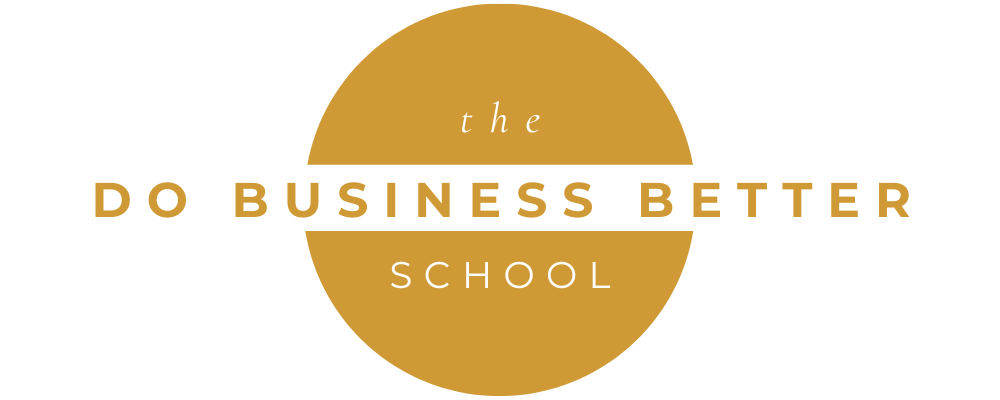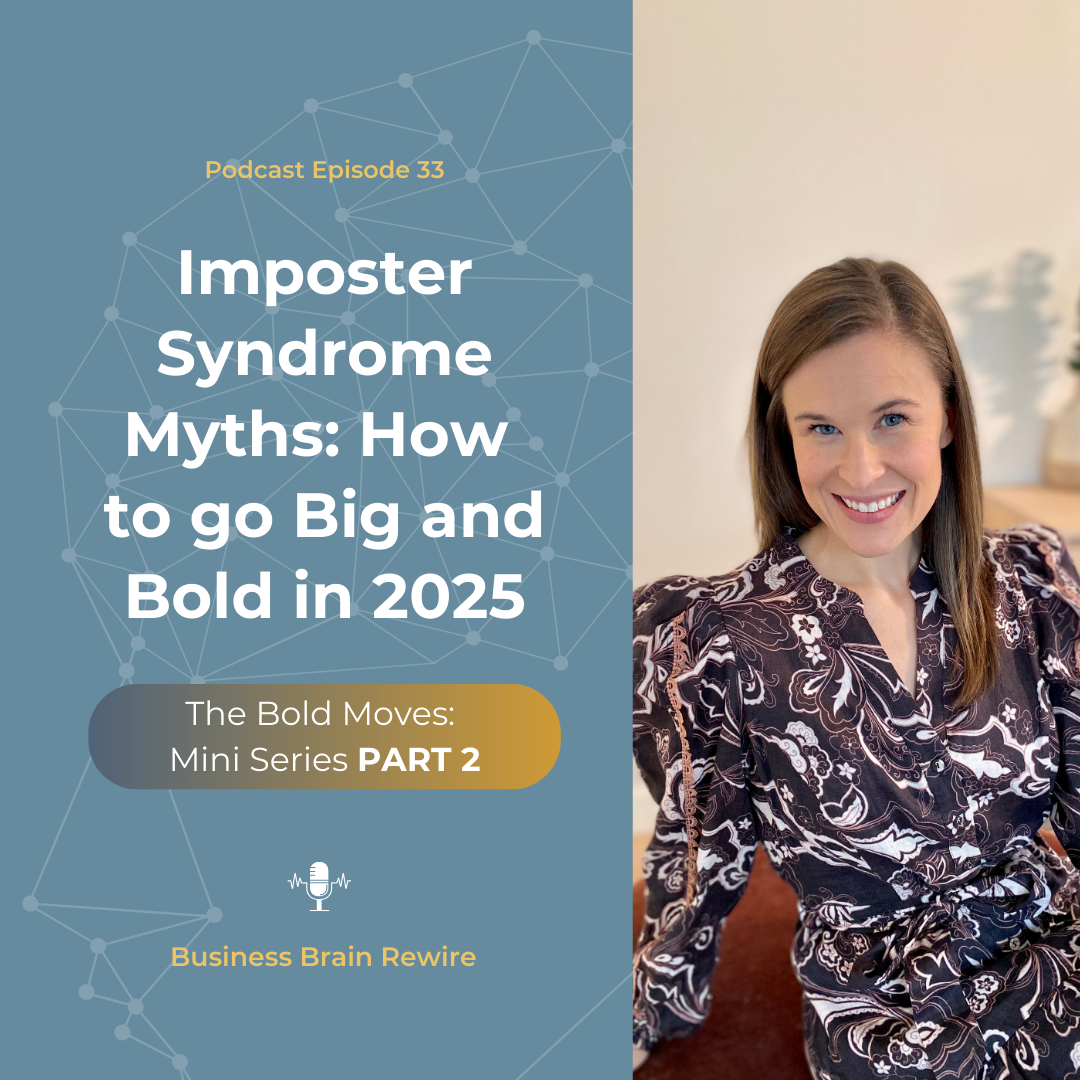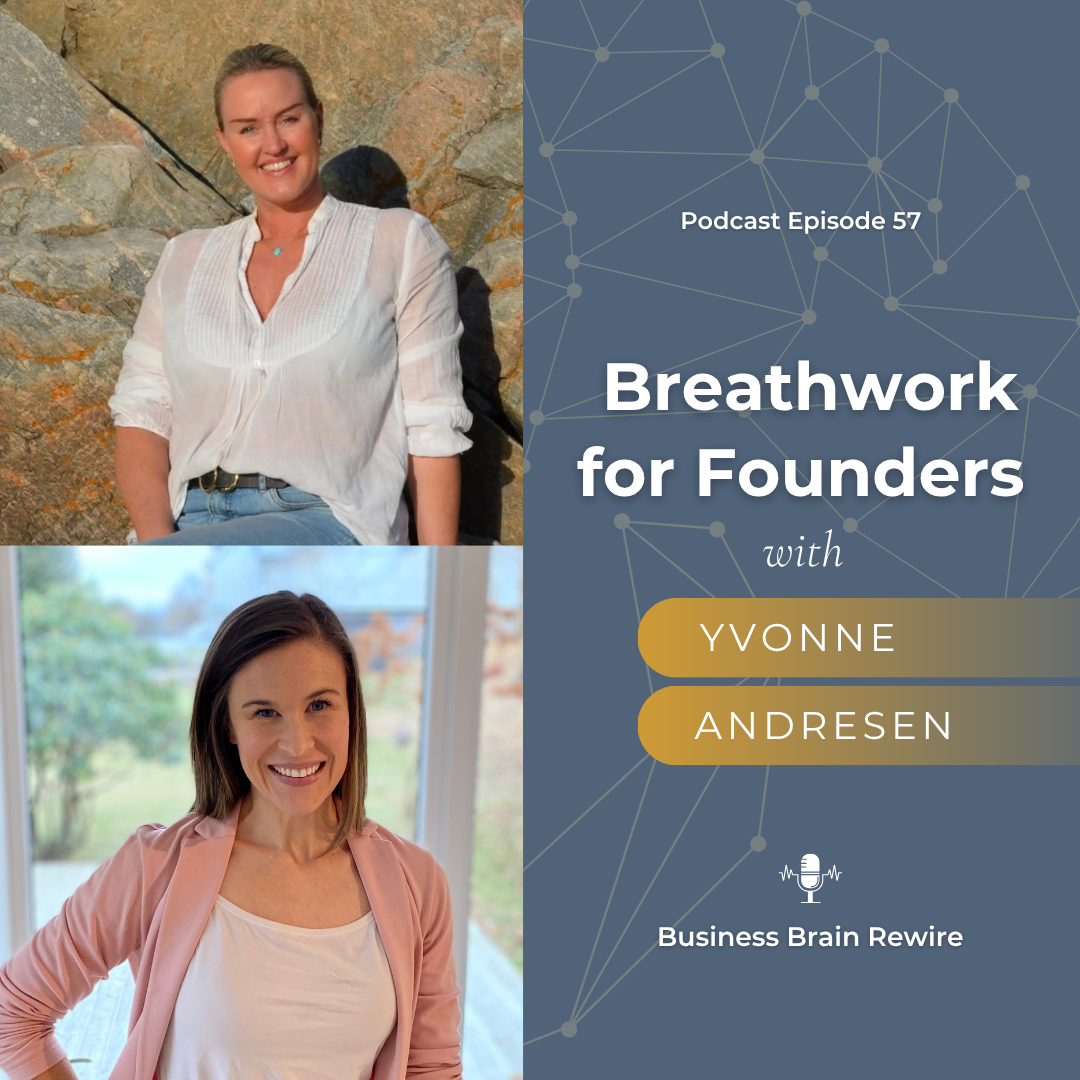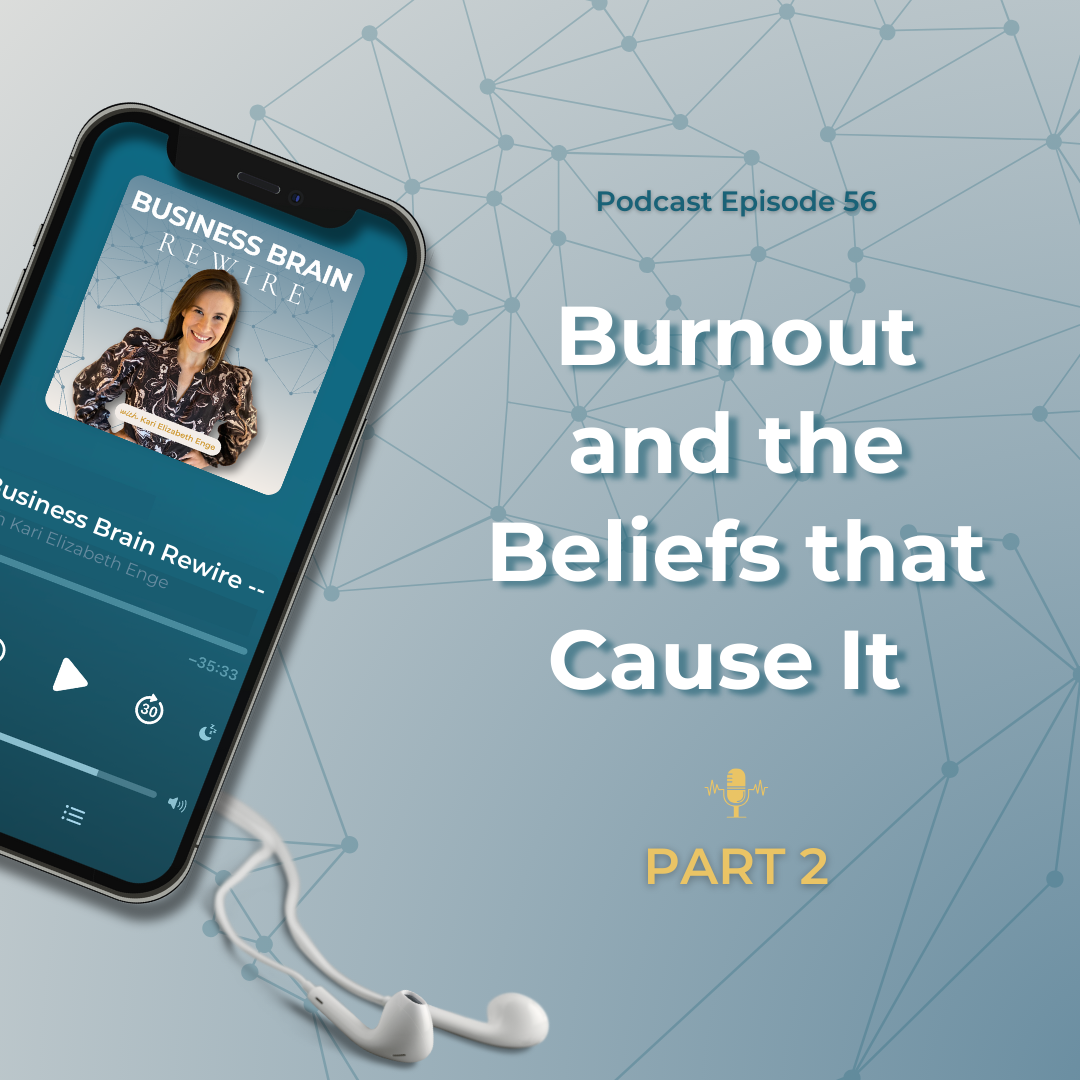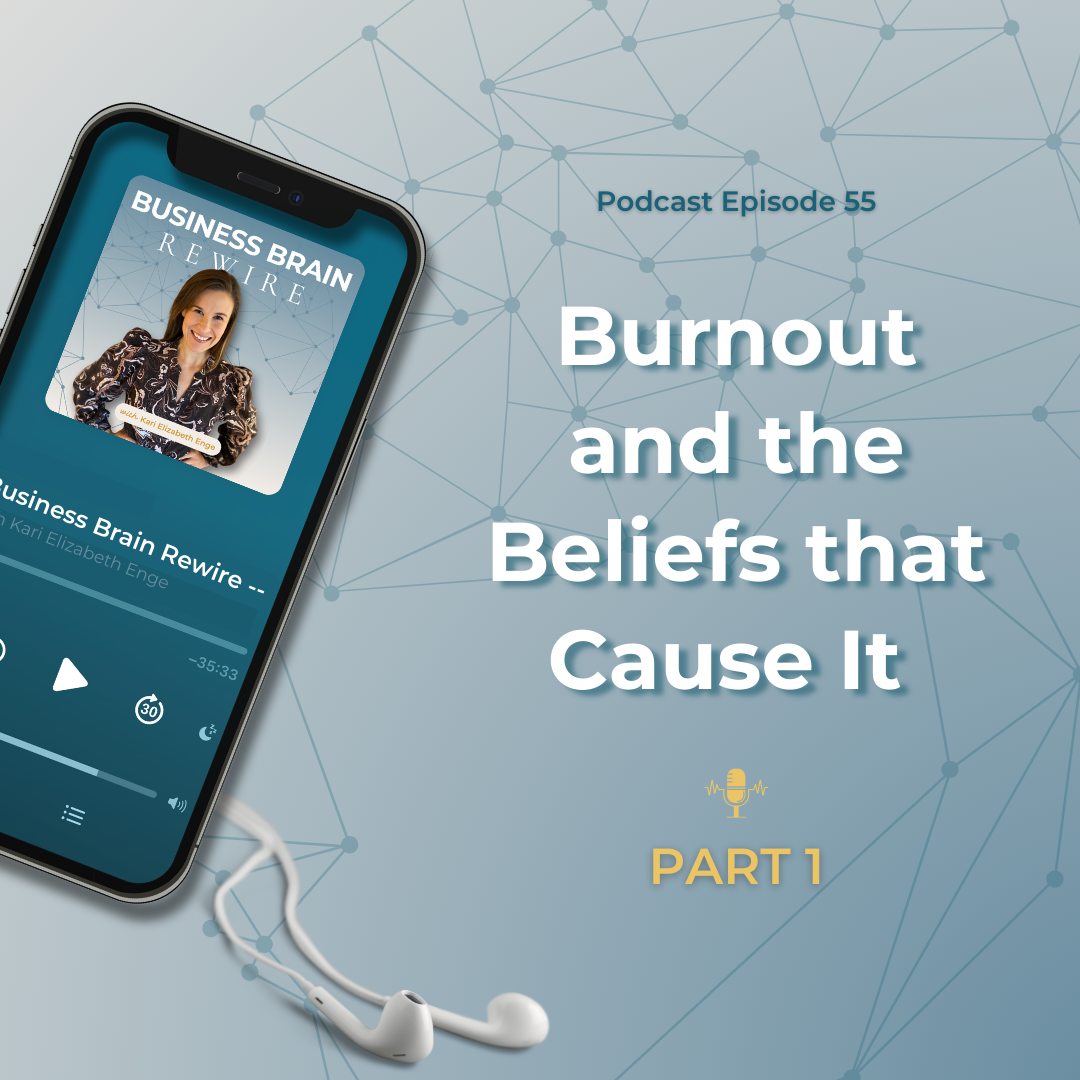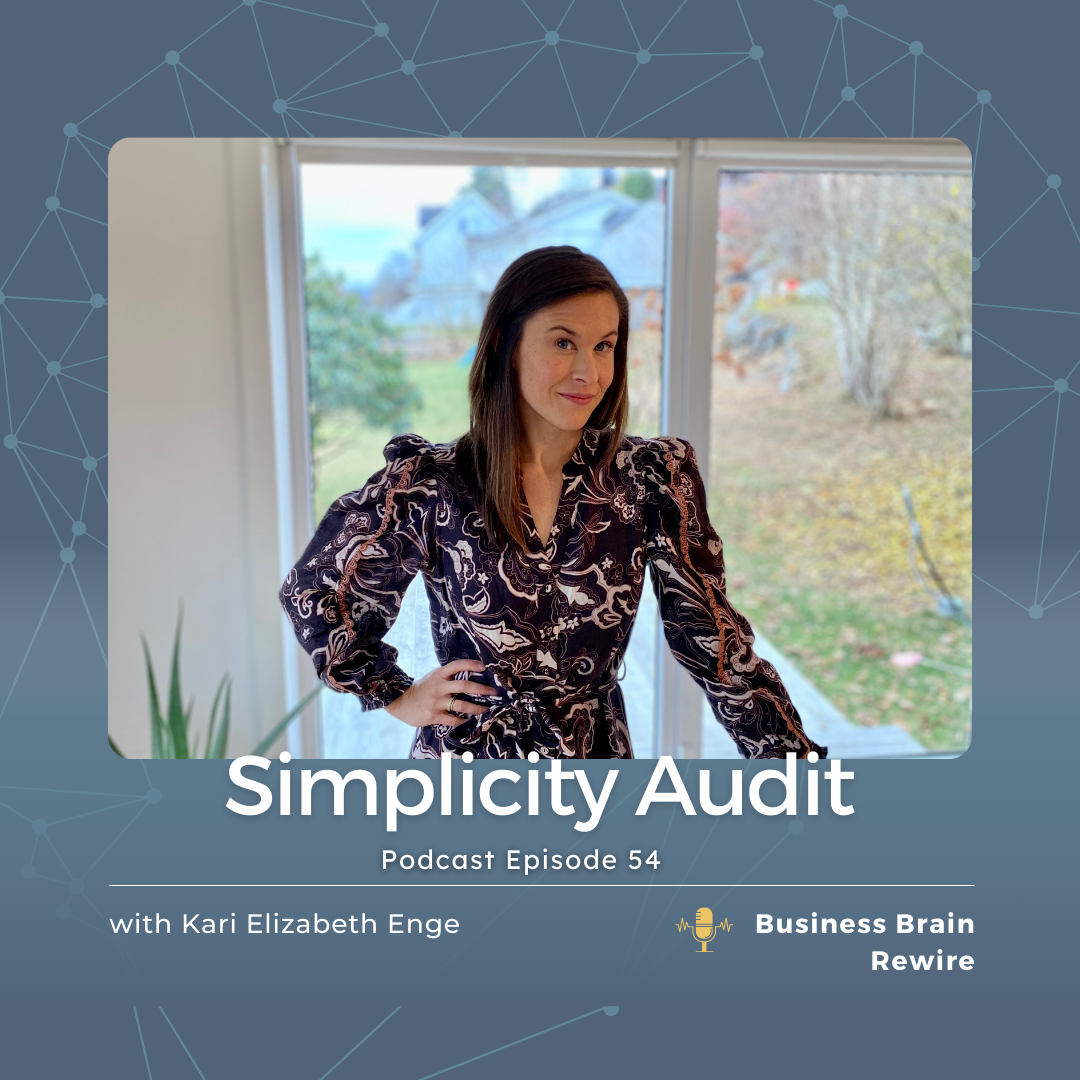Whether you’re a seasoned founder or just getting started, those nagging feelings of doubt and uncertainty can creep in and derail your plans.
In this episode, I break down the myths surrounding imposter syndrome, showing you how it’s rooted in your nervous system, not your abilities. Discover how nervous system states influence procrastination, overthinking, and fear—and, more importantly, how to shift into a place of grounded confidence with simple neuroscience-based tools.
If you’ve ever questioned your niche, pricing, or decisions—or if you’ve found yourself stuck in analysis paralysis—this episode will give you the clarity and confidence to move forward toward your next big vision.
And don’t miss the bonus: an introduction to the 21-Day Nervous System Reset for Founders, a game-changing course to help you unlock founder peak performance.
Step into your 2025 goals with more ease and effectiveness than ever before by ditching old-school “fake it ‘till you make it’ and ‘try harder’ tactics using the latest neuroscience techniques.
[00:00:00] Hello purpose driven entrepreneurs. If you are just joining us for the bold moves mini series, welcome. This January, we have been talking all about how to go bigger and bolder and move the needle with more effectiveness and more ease in 2025. So if you are just joining us, I invite you to check out episode number 32, where we’re talking all about what massive action is and how to tap into it in a sustainable way.
[00:01:15] Today we’re going to continue this conversation by talking about imposter syndrome. Now I have been talking a lot about imposter syndrome over on LinkedIn and on socials, and I’ve been getting lots of good questions. So I thought it would be really helpful for us to talk about imposter syndrome during this mini series because imposter syndrome and the way that you overcome it really mirrors many different challenges that entrepreneurs face when it comes to not moving their businesses forward in a big and bold and effective way.
[00:01:51] For example, if you feel like you don’t quite know if you have the right niche or the right price or the right messaging or if you have confusion and complexity and you’re kind of second guessing your decisions. If you are procrastinating or you tend to get burned out. These type of symptoms, even though they may seem very unrelated to imposter syndrome, actually are very similar and in many ways they come from the same root issue and how we overcome them is also the same. This episode is going to be highly helpful for all of you, because we can take imposter syndrome as sort of the Guinea pig, and then you can use the same process for pretty much any other founder symptom or challenge that you’re facing that you feel like is in the way of you going bigger and bolder.
[00:02:44] Let’s kick off this conversation by talking just a little bit about what imposter syndrome normally refers to and some of the symptoms and challenges that go with it. Imposter syndrome is most commonly associated with brand new founders where they feel like, you know, they’re out of their league. They don’t know what they’re doing.
[00:03:07] Most commonly, this will result in an inner dialogue that looks something like, who are you to be doing this, and a sense of you not being qualified or confusion around the best way forward. It can often cause things like procrastination, complexity or confusion around what type of business you should actually have. What the right pricing maybe should be. What the right marketing strategy should be. Ultimately it will cause this feeling of, you know what, I just need to think about this a little bit longer. I can’t take action.
[00:03:47] If you are a new founder and you’re in this place, you’re probably nodding your head, like yep, that sounds about right.
[00:03:54] And if you are not a new founder and you’ve been in business a while, what I want you to do is instead of turning off this episode, because you think this doesn’t apply to you. I want you to think about the last time that you have questioned yourself. The last time that you have been troubleshooting and just felt like, you know what, I don’t exactly know what the right direction is going to be. Or the last time you have been making a decision and gotten stuck in analysis paralysis. Any time in the last six months you have procrastinated. I guarantee that every single one of you, no matter how long you have been in business have had some indecision, slow decision-making, confusion or a procrastination in your lives. So this conversation is not necessarily just about quote unquote imposter syndrome for a newbie. It is about everything that comes from this place. When you fall into it from a neuroscience perspective.
[00:04:58] Once you understand that you have some of the symptoms related to imposter syndrome, which normally are associated with stepping back or delaying or not boldly moving forward toward the thing that you’re scared of, then we can start to talk about the steps to actually overcome this. In order to do that, we need to understand what causes it. Okay. Any time that you feel like you can’t just step simply into your action plan, because there’s something in the way, we need to make sure that we understand the nervous system state that it is associated with. If you’ve been following along in business brain rewire for any length of time, you know that we talk a lot about the nervous system. This is that neuroscience piece of the coaching you’ll receive here. And each nervous system state that you fall into has certain thinking and sensations and feelings and actions associated with it. You don’t just have imposter syndrome or you don’t just procrastinate because it’s your personality. These things are associated with a particular nervous system state. You’ve probably heard of fight flight freeze. You probably learned in biology class that you can go into these same states, just like a deer would freeze if headlights of a car come and hit that deer who’s maybe walking across the road.
[00:06:36] But we have the same nervous systems. Ours work very, very similarly. And when we are in imposter syndrome or procrastination or confusion or complexity, or in decision or analysis paralysis, all of these things are associated with a certain nervous system state.
[00:06:57] Now there are actually nine nervous system states that we, you know, operate in, as entrepreneurs. If you are curious about all nine of those, I just want to quickly as a caveat, say that my 21 day nervous system course specifically for founders, is out, it just launched and it’s on sale right now, just in the month of January. So I’m going to link up to it in the show notes because it is an excellent, in depth course, that teaches you about all nine of the nervous system states and helps you to tap into the peak performance states of ventral vagal and play so that you can be more effective as a founder and grow your business with more speed and ease.
[00:07:41] For today’s episode, what I want you to come away with, is an ah-ha moment. Realization around the science of imposter syndrome. The science of all the symptoms associated with it, which make you pull back and delay and procrastinate on your business goals instead of stepping into them with that speed and ease that I was just mentioning. When you are confused or you’re procrastinating, or you just don’t quite feel ready yet, or you feel like a newbie, you feel out of your league.
[00:08:23] This is associated most commonly with a couple of dysregulated nervous system states. Now in order for you to understand how your nervous system works, it’s really helpful to imagine a traffic light.
[00:08:42] You can either be in green. The green light of your nervous system. The yellow or the red. When you’re feeling safe, fundamentally, this is going to be the green light. This is where you feel grounded and settled and calm and at ease and focused. You can enter into the place state. You are not stressed out. You are not, you know, super task oriented and busy. You’re not frustrated or irritated. You’re not confused and holding back. You are motivated to get out there for your business and talk about your business and it feels really safe and doable and fun for you to do so. That’s the green light.
[00:09:31] Now when your nervous system picks up on a threat and this can be a real threat, like, oh my goodness, cashflow is low or it can be a perceived threat, like, I don’t know if this person will say yes. I don’t know what’s going to happen next week. I don’t know if this person’s going to give me good feedback. Whatever the concern is it will move to the yellow light. This yellow light represents our sympathetic nervous system where we go into fight or flight. Adrenaline and cortisol rush through our system. This helps to activate us to fight off the threat. This is where you will get more busy. You’ll feel like things are more urgent. You will get really task oriented or you might start to overthink things and run away from the threat using your thinking. Right? What is the right way to do this? How do I solve for this?
[00:10:33] And when you are in flight, especially you will start to get into that analysis paralysis and some of that slow decision-making, but your brain will be very busy. You’ll be thinking about your business all the time. So you will be using a lot of energy. You’ll be tiring yourself out, but you’ll be doing all the work in your brain. This is the yellow light.
[00:10:58] Now, if the threat is too soon, too big, too much for your nervous system. So this is not like a cognitive decision we make, but this is something that our nervous system decides automatically on our behalf. It will move to the red light. This is where you actually move to what we call the dorsal vagal branch of your vagus nerve. It’s the same branch that reptiles moved to, automatically, where they play dead and freeze in an effort to survive the threat. So this can be associated with that procrastination, that brain fog, that overwhelm, that just feels like I’m stuck. I know I need to do something. But I’m stuck. I don’t know how to move forward in the best way. It can also put you straight into what we call shutdown. Which is where you feel really drained. You can’t get out of bed and that inner critic, those shaming thoughts, those hopeless thoughts start to come in which further train your energy.
[00:12:07] So it’s really important that as we talk about how to go bigger and bolder in our businesses, that we understand, we’re not just talking about fake it til you make it and do some sort of power pose. You know, think positive thoughts and eventually you’ll succeed. All of that is just old school, outdated tactics that don’t actually solve for what’s going on. We need to solve for it at the level of our nervous system, because that’s what’s calling all of the shots. It’s really impossible to move forward in your business in a big and bold way when you are in the red zone.
[00:12:46] It’s also really hard take it clear and confident and to simplify your strategy to those needle movers, when you’re in yellow. Because your brain is going to be spinning and overthinking and complicating and adding a lot of actions to your plan that are actually unnecessary.
[00:13:05] You’re not in charge of your thinking when you are in yellow or red. Your brain is operating through a lens of threat. So we have to get you back into the green zone. So that your brain can access it’s prefrontal cortex so you can feel calm and grounded and therefore, step into your business in a much more doable way.
[00:13:29] This is just the science. This is just what we know about how the vagus nerve affects our nervous system and what happens from a biological standpoint when you experience stress. This is very applicable to you as a founder. This science is so important. What I love about the science is that it completely removes all shame from this conversation. Because a lot of times when we have imposter syndrome, me included, you start to have this, you know, ugly inner critic that tells you you’re not qualified, but then also tells you that you’re pretty stupid for thinking like this in the first place. You know, you should be past those by now. Why is this taking so long? Why are you still struggling with this thing? You shouldn’t be insecure about this, right? So it’s like that double arrow. You feel bad about the fact that you don’t feel qualified and then you feel bad about thinking you’re not qualified. We can just stay in this shame spiral, when we think that we actually have cognitive control over all of this. When really what’s happening is our nervous system is triggered from a primal standpoint and all we need to do is to understand the science and to normalize these nerves and learn how to work with them, instead of just continuing to beat ourselves up because that’s not working anyways. Right?
[00:14:52] It’s also not working to keep waiting and waiting and waiting until we feel ready, cause that’s not going to happen until we move into the green zone. I hope that helps you to understand a little bit of the science. It’s really important that you realize that this happens to everybody, no matter at what level they’re at.
[00:15:14] Oftentimes as beginners, especially, we think, oh, when we experience success, when we have more experience, we won’t go into the yellow and the red zone. We’ll be confident and we’ll be settled. We’ll be grounded. We’ll be feeling good and everything will just be easier than it is now. That’s actually false.
[00:15:36] You will have moments where you dip into dysregulation and into the yellow and into the red all the time, because you’re constantly doing new things in your business and you’re constantly growing it as a founder, and your nervous system is constantly triggered. This is just how being a founder works. So once you bust through the next level that you’re at, the next level is just been a trigger you. So the sooner we can learn about how to work with our nervous system while removing the shame, that the world has put on us in the past to say like, you should be better than this. You should just try harder. You should just have more willpower and discipline. The sooner we learn how to meet ourselves, where we’re at to notice the nervous system triggers that bring us into yellow and red, and then move back into green, using simple neuroscience-based tools, the better. Because it’s just going to keep happening over and over and over again, if we don’t learn the tools that help us to stay regulated, we will just keep struggling and we’ll always reach some sort of plateau in the business of eventually.
[00:16:48] So that brings me to another thing that I mentioned in my LinkedIn posts that got a lot of attention from you guys, because I said, you know what? Imposter syndrome is like not a thing. It’s not a disease. I think that a lot of times we think of it like that, we’re like, oh no, I have imposter syndrome and now I need to learn how to like, get over it and move through it and to solve for this thing like it’s cancer.
[00:17:15] It’s really not a disease. It’s just a mask. It’s a mask covering up the real issue. The real issue is fear. The way we solve for fear is to regulate the nervous system, because the only reason why we feel the fear is because the nervous system is in dorsal vagal or sympathetic states. So I would love for you, you know, as a takeaway from today’s episode, is maybe to even stop talking about the concept of fear. Because it’s used a lot in the coaching industry. It’s used a lot in the entrepreneurial space. It’s like, you know, feel the fear and do it anyways. Like, I think there’s even a book that’s called that.
[00:18:00] Instead, what we want to do is say, you know, what fear and our traditional way of thinking about fear is really nervous system dysregulation. We need to understand which nine of the states our nervous system has fallen into so that we can guide our nervous system back out of that state. We don’t just need to feel the fear. We don’t just need to fake it till we make it. We don’t just need to be more disciplined. We don’t need to get a better planner, a better morning routine, a better calendar. We don’t need accountability. All of these things are just solving and putting a band-aid on the masks. Instead we need to solve for the root problem. And the root problem is not your fault. You don’t just decide that you’re going to go into the dorsal vagal branch of your ficus nerve. This is something that your body does based on how it is scanning and dealing with or reacting to stressors and potential .
[00:19:01] So I hope that that gives you a little bit of an intro into what’s happening. And again, if you want to understand the science of the vagus nerve and how it works, join me for that 21 day reset, cause that’s really gonna help you once you know exactly what’s going on and exactly how this works.
[00:19:18] Once you understand what imposter syndrome and all of the related symptoms are, we want to start to solve for it in the most sustainable way, by really tapping into the root issue.
[00:19:33] The first thing that’s really helpful is to get a lay of the land of what’s going on in your brain. Oftentimes, we just let the brain spin in our mind and we don’t actually dump all of our thoughts down on paper to look at all the concerns and the questions. So a wonderful exercise that you can do, was coined by one of my teachers that I have a certification in, Brooke Castillo of the life coach school, she teaches an excellent tool called the thought download.
[00:20:24] It’s exactly what it sounds like. It’s just downloading all of your thoughts out of your brain and getting them down on paper. And I do this exercise every morning. I just clear out the clutter. Clear out the closet of my brain, so that I get out of those spinning thoughts, those ping pong thoughts, that are not actually getting my full attention and getting resolved. They’re just kind of like spinning as noodle brain in the background, clouding my focus. I get them down on paper and I look at them. That is an excellent way to get the vagueness of imposter syndrome down on paper. So we can look at what the nervous system might be reacting to. We want to put things like, I don’t think my price is right or I’m not sure which direction is best, or I don’t have enough time or we don’t have the funding lined up or, you know, I don’t have this yet. Whatever the roadblocks are, or even just the questions that you have in your mind, those are all contributing to the nervous system dysregulation, and we have to see what they are so we can solve for them. That’s really step one.
[00:21:33] Now. Doing this is going to give you a very long list, you should have like 20, 30 things down on your list and then you’re probably going to feel super overwhelmed, like, oh my gosh, I can never get past all of these issues. But here’s the thing. A lot of people won’t do this exercise because they don’t want to face the reality. So this exercise will be confronting. It will be potentially overwhelming, but you are feeling this all the time. You were just kind of shoving it down and resisting it and whatever we resist just grows bigger. So you weren’t actually solving for it when it wasn’t on paper. It’s just now we’ve heightened the uncomfortable sensation that you’re now feeling. But we’ve actually moved forward with the discomfort of the overwhelm. Once we see everything down on paper. So that’s really the first step that I would recommend for all of you to do and you can do this whenever you’re feeling undecided, confused, in analysis paralysis, held back, get it down on paper so we can look at what’s going on under the surface because it’s calling the shots. No matter if you want to admit it or not.
[00:22:40] Now. What most old school coaching would say is now let’s tackle each of these, put the list in priority and then let’s think about how we can solve for it. How could you solve for this? Just to go straight to the actions and the ideals from a practical standpoint. But I want you to imagine that this is the same as going to a marriage counselor. Okay. So I want you to imagine that you were having marital problems and you’re fighting with your spouse and you just cannot get resolution around this really tough thing. Communication is just awful. You always end up in a fight. You always end up not seeing eye to eye. And so you hire a marriage counselor to help you to solve this issue. When you get into the marriage counselor’s office, she sits you guys down on the couch and she hands you a Baton, and she says, okay, here’s what I want you to do for your homework. I want you to go home and I want you to use this Baton and you can’t talk if you’re not holding the Baton and the person who’s talking gets to hold it until they’re finished and then they’ll pass it to the other person. Like this is what old school marriage counseling did. It just said, okay, here, I’m going to give you this practical action based thing to try, similar to like start on a good morning routine, right, as a founder. It’s going to solve all of your mental and emotional roadblocks. It just doesn’t make sense.
[00:24:05] Because the reason why you have marital problems is because of a mental and emotional disconnect, not because you just don’t know how to stop interrupting each other. Because the reason you’re interrupting each other is because you don’t feel emotionally and mentally safe and connected. So we want to make sure that we don’t do this as business owners. We don’t try to use the metaphorical Baton in order to solve things that are much deeper. That are coming from thoughts and feelings and nervous system states. So, this is why you definitely don’t just want to try a better morning routine. It’s never going to work for you.
[00:24:42] Now. WhI you think is really helpful at this point is instead of prioritizing your list and then trying to like, get clear on the number one problem or the number one concern, is that you get help with regulating your nervous system and creating safety around that item. We do this, not just using your thoughts. So, for example, let’s say that the thing that’s causing your nervous system dysregulation and causing this imposter syndrome, like the number one thing on your list was, I don’t feel like I can talk about my business in a very clear way. I feel like the message is cluttered. The number one thing that a founder might do then is to rethink the message over and over and over again, and maybe spend a lot of time trying to, you know, craft a compelling message. Maybe they spend thousands of dollars on a copywriter, or they try to change the name of their company. I’ve seen this over and over again where the founder just thinks that changing the name of their company is going to bring them the competence in the aligned feelings that they want.
[00:25:56] Instead of doing this, we need to look at: okay, what is the feeling associated with not having compelling messaging? Because the brain wants to go to the Baton, the action. Oh, I need to hire a copywriter to give me more compelling messaging. But we need to look at, what is the feeling and nervous system state associated with this?
[00:26:16] It might be confusion. It might be insecurity. It might be a concern. It’s going to be different for every single founder, but that’s really what we need to highlight. Because then we can go to my visual tool called the founder performance spectrum and map out which nervous system state it goes with. For example, let’s say you feel like you’re confused, that would be associated with the free state. Then how we get out of the free state is a very particular, it’s different than getting out of flight or flight or shut down. We have to meet the body where it is and use a body-based somatic tool in order to show the body. You’re actually not experiencing a life threat. You’re safe in this moment. You’re in Vegas nerve actually has many, many neural connections and most of them send signals from the body to the brain. About 80% of them run from the body to the brain.
[00:27:21] What this means is that we don’t want to go straight to mindset work, straight to our thought process, in order to overcome imposter syndrome or confusion or any other symptom. We have to show the body, through our senses, that we’re actually safe. Because 80% of that system is running from the body to the brain. This is neuroscience that we just haven’t had prior to 1990. The business world, especially, is very behind in their understanding of this. So they try to motivate and create confidence and founders only using brain down approaches, instead of also incorporating body approaches. Now you might be wondering what the heck is a somatic movement. Somatic movement is simply a gentle movement that shows the body that you’re safe. This could be as simple as swaying from side to side. It could be a breathing. Technique to slow the breath down. It could also be speeding the breath up if you’re in dorsal vagal, and you’re very low energy, we can use breath to actually speed the system up. This is why I said you don’t just want to use any tool to try to solve for your nervous system state, because depending on which nervous system state you’re in, you would use a different tool. There are many different types of somatic movements that we can use to guide the body to register safety. When you do this, your thoughts change because of these body to brain odd neural pathways. And how the vagus nerve actually works inside of our bodies.
[00:29:07] This is really exciting because it means that we don’t have to struggle with mindset tools, and we don’t have to spend a lot of time on cognitive behavioral therapy, especially when we’re finding resistance. It’s really hard to believe a helpful thought, like. I’m ready. Right? That can only get you so far. If you’re in dorsal, vagal shutdown.
[00:29:28] We want to incorporate the latest neuroscience and simple movements and other simple techniques in order to just show the body it’s safe, and these can take three to six minutes. They don’t actually take that long in order to use. So this is really exciting stuff, because you can imagine if you are about to go to a pitch in an investor meeting, or you’re about to walk into a sales meeting. Or you’re about to do a webinar or you’re about to do a consult call. We can spend three to six minutes doing a somatic reset, and instantly show up more clear, competent and grounded. Thinking more high level thoughts than if we just went into that call, noticing our nerves and not doing anything to support our nervous systems in that environment.
[00:30:17] We don’t have to spend all day meditating. We don’t have to go to expensive breath, work classes or yoga classes. We can just do things for three to six minutes. Before these moments of visibility and selling, and it really changes the game. So that is the next step that we want to do after we get a lay of the land and do that thought download is to register which state of the nervous system am I in, and then to use a somatic tool to guide ourselves back out, this is going to bring you so much further than you actually realize. It’s so simple that you probably don’t believe me right now.
[00:30:53] What I want you to do is if you’re curious, sign up for the reset. You’ll be so blown away by how these tools work. I’ve become so passionate about including this in my business coaching because of how powerful these tools are, especially for founders.
[00:31:09] Now the other thing that I want to talk about briefly on today’s episode is about uncomfortable body sensations. Because it’s really important when we talk about any type of imposter syndrome or procrastination or concern or worry, or fear or analysis paralysis or any type of these negative symptoms that we acknowledge. That it’s not just something that’s happening in our brain. There is a body sensation that goes with it. This is not something that the business world will talk about at all. They’ll talk about like, okay, what are you scared of? What’s the thought? And then how do we make you more competent? Yes, we need to work with your beliefs and your thoughts and the narrative you’re having around it. But we also need to understand that the reason you’re getting triggered, or one of the reasons you’re getting triggered can often be because you don’t have the skillset and the current capacity to hold the big sensation.
[00:32:05] Let me give you some examples. This could be butterflies in the stomach. It could be the slight feeling of nausea. It could be a lump in your throat. Tension in your shoulders. It could be a sinking feeling. All of these are actually just body sensations. They don’t mean anything until they hit our brain and then our brain makes a story about what it means. So for example, if you have butterflies in the stomach, it could be like, oh no, I’m not ready, I’m not qualified. But the sensation of butterflies in your belly is just a sensation. It doesn’t actually mean anything.
[00:32:40] I think that this is where a lot of founders get stuck. They experience a lot of overwhelming sensations. And those are so overwhelming that it just completely derails them and causes that procrastination. Then their brain goes online and starts to tell them why they have butterflies. And it starts to start the shame game of you’re not qualified.
[00:33:03] You’re not ready. This is not the right company. Will you ever succeed? And so on. And that narrative is what we associate with imposter syndrome. But what we want to start to do is to start to tease out and separate the body sensation from the narrative and the storytelling. Can you just be with butterflies in your stomach without going into the shame spiral without going into the narrative into the story. Can you just notice the story and separate it from the sensation? This is actually a skillset and it’s called interoception and we have found in research, which I’ll try to link up to in the show notes.
[00:33:47] Research has found that this skill set is the highest in Olympic athletes and Navy seals. So really high capacity people doing badass stuff. They actually more naturally. Are able to be with sensations and separate that from narrative. The great news is this is not just a natural thing that you’re either born with, or you’re not born with. It can be learned. It can be practiced and you can expand your capacity to be with any and every sensation so that it doesn’t trigger, fight flight freeze, and other dysregulated nervous system states.
[00:34:26] So this is a big key to overcoming your imposter syndrome, your nerves, your insecurities and your concerns. Because if we can teach you how to just be with negative, you know, sensations, uncomfortable sensations, and to separate that out, you get to go for whatever you want to go for because the sensation is just not going to matter. You can just handle it and feel grounded and safe while doing so. It really changes the game. The way that we build this capacity is not some woo woo spiritual thing. It’s simply spending just a little bit tiny bit of time in that uncomfortable sensation, like literally five seconds, if that’s all you can do and then coming back out of it in a safe way, and then going back in like microdosing. Except for, we just pinned you later, titrate in and out, in and out, and you can do this in a safe way with someone you feel safe with, who can guide you to make sure that your system doesn’t get overwhelmed.
[00:35:32] Once you train the nervous system, oh, you can be here and it’s safe, then you will feel so much more calm and grounded the next time your nervous system experiences, those sensations.
[00:35:46] So I have done this over the last several years with public speaking. I have taught at some bigger conferences than I ever have before in the last two years and become much more visible in my company. I’ve taught to just larger audiences and I’ve had to expand my capacity for that excitement. For those butterflies, those sensations of anticipation, without letting my brain come online to give me a story about if I’m ready, if I’m qualified, if I’m going to do a good job, and if I’m going to grow my company, or if I’m going to completely just bomb.
[00:36:25] Over time, I have expanded my capacity for those emotions and those sensations to, so that I can step onto the stage with more confidence. What I’ve seen over time is that I’ve actually been able to tap into the place state. While teaching with those really big audiences and I’ve reduced my prep time for them simply because I feel safe. So these tools can be extremely powerful and practical because they help you to actually implement the strategies and ideas that you have from a sales and marketing perspective. All right.
[00:36:59] I hope that this episode has been eyeopening. I hope that it’s given you some new things to chew on and reflect on the biggest takeaway that I want you to have today is that imposter syndrome is not a disease. It’s not a thing. We really need to break it down to what nervous system state is this, and then we need to use modern neuroscience-based tools to bounce out of it. The last thing that I will say is that this is not complicated and it doesn’t take a long time. Even though this is maybe new science, that you’ve never heard before, it doesn’t mean that this is complicated or hard. Anyone with an elementary school degree can do it. Especially if you’re an adult, I think sometimes it’s harder for kids to do this because they just can’t sit still, to do the thing. Although I have my kids do nervous system reset exercises all the time and they just don’t know it. But it’s something that anyone and everyone has access to and it’s simple, especially when you get training from someone who’s going to help you to use it in your particular context, like being a founder. Okay.
[00:38:10] Make sure you check out that reset in the month of January. You really want to take advantage of this course, while it’s available. I hope that you have a wonderful week going bigger and bolder for the impact that you want to create in the world, through your company. Have a wonderful week and I’ll see you soon.
